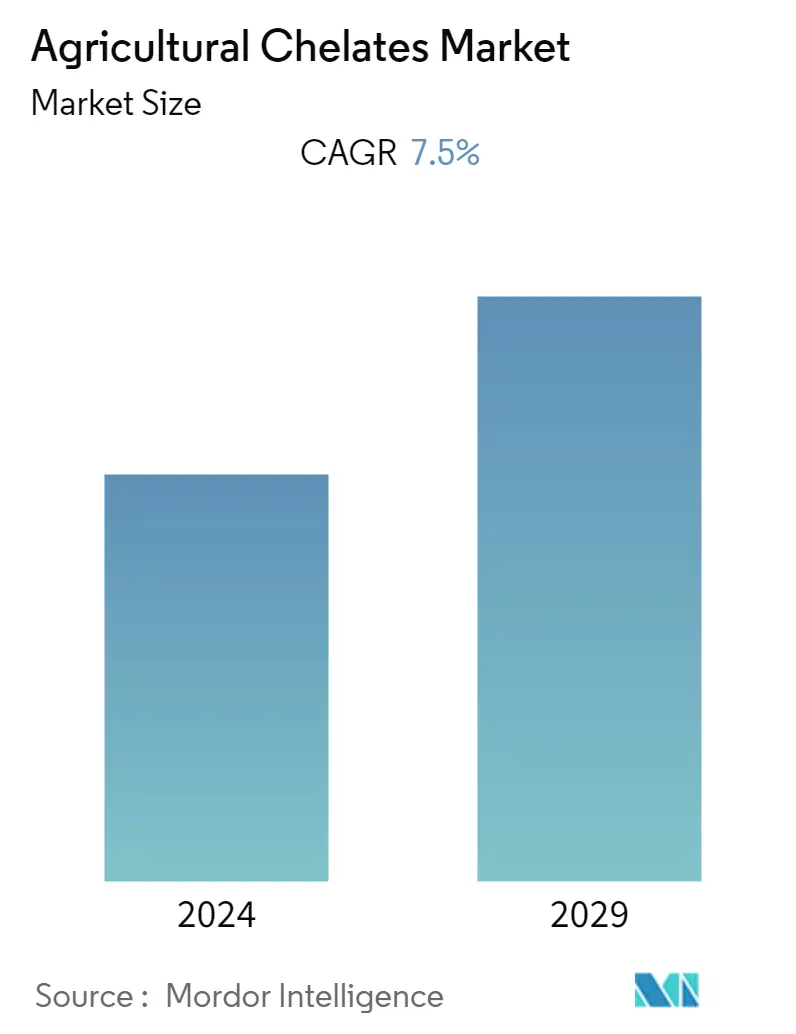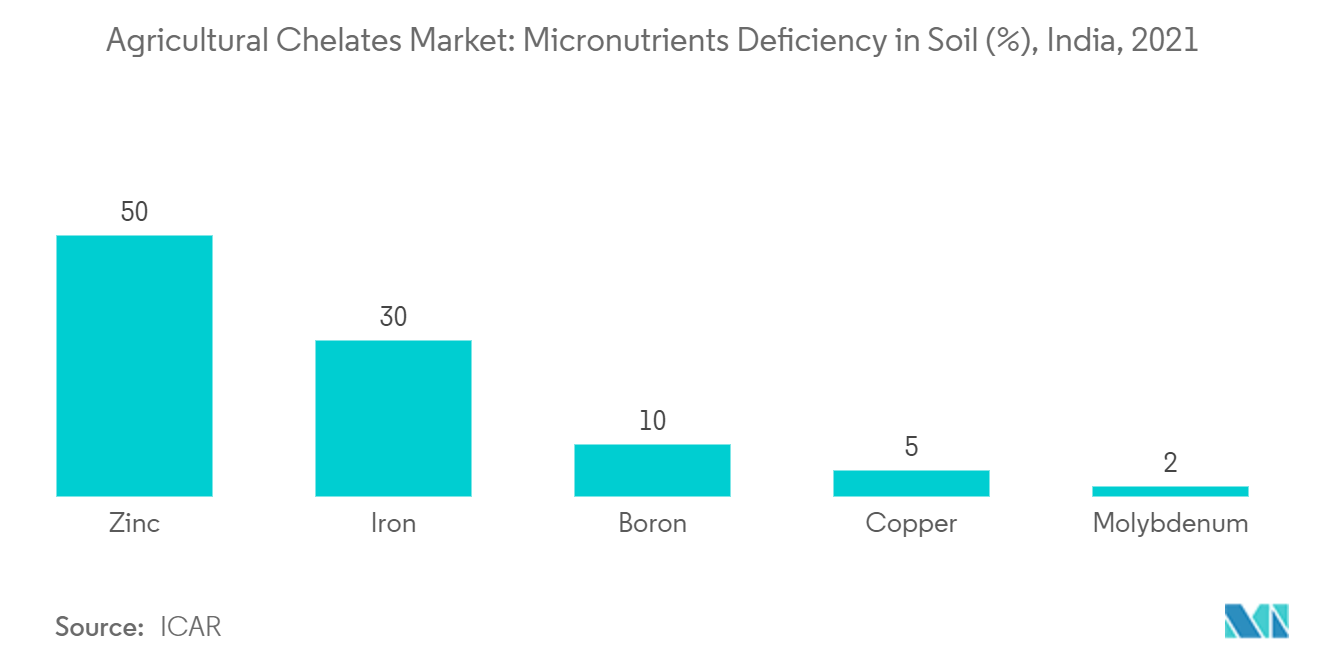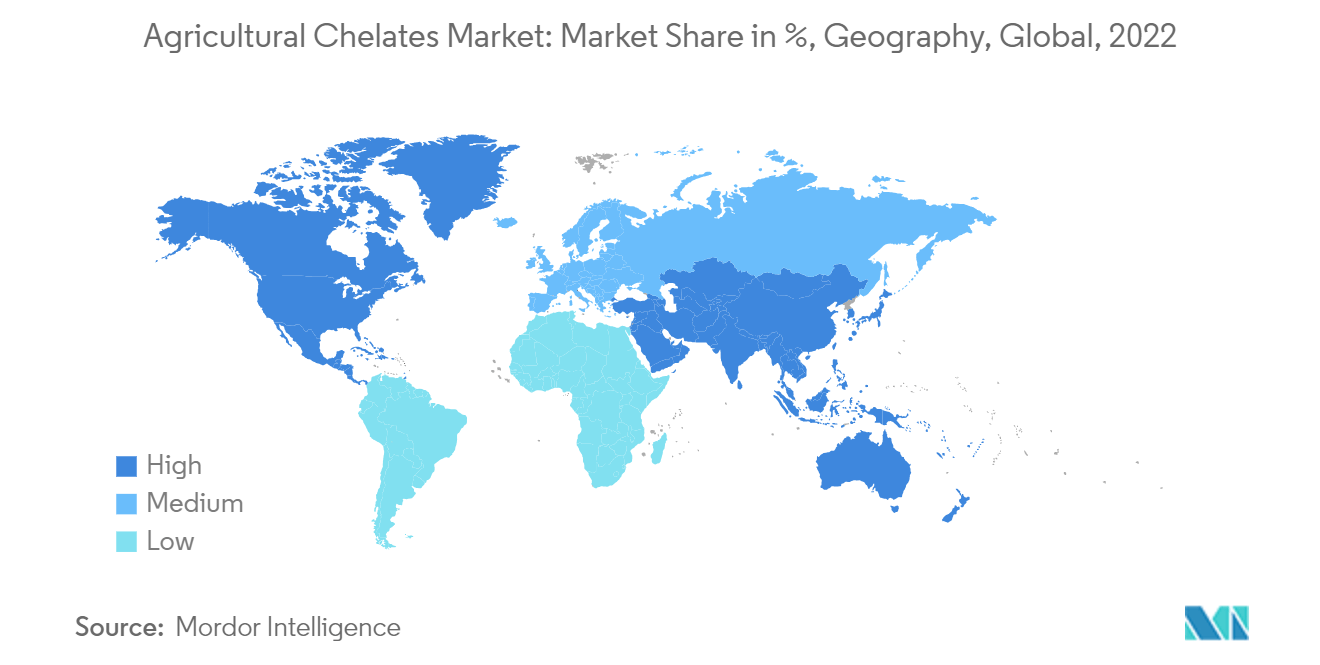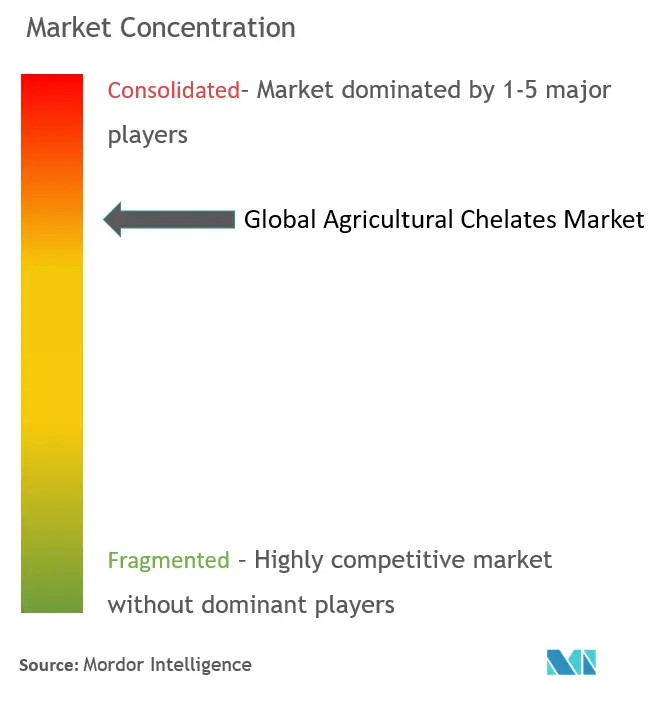Agricultural Chelates Market Size

| Study Period | 2019 - 2029 |
| Base Year For Estimation | 2023 |
| CAGR | 7.50 % |
| Fastest Growing Market | South America |
| Largest Market | Asia |
| Market Concentration | High |
Major Players.webp)
*Disclaimer: Major Players sorted in no particular order |
Agricultural Chelates Market Analysis
The agricultural chelates market is valued at USD 968.9 million for 2022 and is projected to register a CAGR of 7.5% during the forecast period.
- Changing climatic conditions, decreasing availability of arable land, and increasing global population are raising food security concerns. As a result, there has been a significant rise in the use of chelating agents in the agriculture sector to improve crop yield and meet global food demand. Chelating agents help improve plant nutrient uptake by making certain nutrients available. This process can improve plant growth and development and increase crop yield and quality.
- Since soil is heterogeneous and complex, traditional micronutrients are readily oxidized or precipitated. Chelation keeps a micronutrient from undesirable reactions in solution and soil. Chelated fertilizers improve the bioavailability of micronutrients, such as Fe, Cu, Mn, and Zn, and, in turn, contribute to the productivity and profitability of commercial crop production. Chelated fertilizers have more potential to increase commercial yield than regular micronutrients when the crop is grown in low-micronutrient stress or soils with a pH greater than 6.5.
- With the rise of sustainable farming and the increasing awareness of the adverse environmental impact of synthetic chelating agents, there has been a rise in the demand for biodegradable chelating agents. Therefore, companies are capitalizing on customers' needs to uphold a leading position in the market.
- For instance, in 2022, Innospec, a US-based specialty chemical company, launched ENVIOMET® C biodegradable chelating agents. When released into the environment, ENVIOMET® C chelating agents rapidly biodegrade, reducing the possibility of forming persistent organic chelates with heavy metals, such as lead (Pb). This results in less risk of soil accumulation and underground water pollution.
- Therefore, the abovementioned factors are anticipated to stimulate market growth during the study period.
Agricultural Chelates Market Trends
Increasing Preference for EDTA in Agriculture
- Ethylenediaminetetraacetic acid (EDTA) is one of the most extensively used synthetic chelating agents in agriculture and finds applications in soil and foliar-applied nutrients. EDTA can also be used for open-field fertigation in the case of soil with a pH range of 6.0. Its wide application is a significant reason behind its holding the largest market share.
- EDTA chelates are widely preferred over other inorganic sources, as they are effective in the uptake of trace elements, such as iron (Fe), manganese (Mn), copper (Cu), and zinc (Zn), from the soil to the roots of the plant.
- As a micronutrient, zinc is crucial for plant hormone balance and auxin activity and is vital for the growth of plants. Organic chelated zinc sources, such as Zn-EDTA (12% of Zn), are generally considered superior to inorganic zinc sources. In the case of corn and bean crops, only half the total is required if Zn-EDTA chelate fertilizer is the source rather than zinc sulfate (ZnSO4). EDTA chelates are comparatively less expensive and readily available than other commercial agriculture chelates available in the market.
- The major players in the market have a comprehensive product portfolio for EDTA being used in agriculture inputs. For instance, Corteva has a wide range of EDTA chelating agents under Versenol and Crop Max, which are highly demanded in agriculture. EDTA chelates are comparatively less expensive and readily available than other commercial agriculture chelates available in the market. Its ability to treat toxins such as mercury, cadmium, and lead in the soil drives the growth of EDTA chelates during the forecast period.

Asia-Pacific Dominates the Market
- The Asia-Pacific region has the highest market value for agricultural chelates, majorly led by China, India, and Japan. As the country with the largest population, China has one of the most extensive agricultural facilities globally. With a rapid increase in population and the increasing demand for food, farmers are compelled to grow crops with high yields. This creates the need for agricultural chelates in the country.
- According to the Government of Australia, alkaline soils occupy about 23.8% of the total land area in Australia, and soils in western Australia have a pH range between 4 and 8.5. Therefore, the demand for EDTA chelating agents is increasing in Australia due to trace element efficiencies, which limit agricultural productivity growth.
- India is witnessing an incidence of micronutrient deficiencies, such as Zn 36.5%, Boron 24.2%, Fe 12.8%, Mn 7.1%, and Cu 4.2%. This has led to severe losses in produce yield and nutritional quality. In line with the nutrient deficiency in the soil and the effectiveness of chelates in combatting it, the demand for chelates is increasing in the country. The Indian market is estimated to grow at a moderate rate.

Agricultural Chelates Industry Overview
The global agricultural chelates market is concentrated. The major players in the market are Yara International ASA, BASF SE, Nufarm, Mitsubishi Chemical Corporation, and Innospec Inc, among others. The significant market share of these players can be attributed to a highly diversified product portfolio and acquisitions and partnerships during the review period. These players also focus on R&D and product innovations to widen their geographical presence.
Agricultural Chelates Market Leaders
-
Yara International ASA
-
BASF SE
-
Mitsubishi Chemical Corporation
-
Innospec Inc
-
Nufarm
*Disclaimer: Major Players sorted in no particular order

Agricultural Chelates Market News
- January 2023: Nouryon, a global leader in specialty chemicals, acquired ADOB, a prominent supplier of chelated micronutrients, fertilizers, and other specialized agricultural solutions in Poland. This strategic move enhances Nouryon's diverse crop nutrition portfolio and underscores its unwavering commitment to the agriculture and food sector. The acquisition enables the company to broaden its range of services and products for industry customers.
- March 2022: The Haifa Group acquired Horticoop Andina, a specialized wholesaler of agricultural nutritional products based in Quito, Ecuador. This acquisition allowed Haifa to expand its presence in Ecuador and the wider Latin American market, further solidifying its position as a global leader in advanced plant nutrition.
- December 2021: Nouryon expanded its office and research center in Mumbai, India, doubling its office space. This expansion is aimed at better serving local customers and supporting long-term growth initiatives in the Asia-Pacific region.
Agricultural Chelates Market Report - Table of Contents
1. INTRODUCTION
- 1.1 Study Assumptions and Market Definition
- 1.2 Scope of the Study
2. RESEARCH METHODOLOGY
3. EXECUTIVE SUMMARY
4. MARKET DYNAMICS
- 4.1 Market Overview
-
4.2 Market Drivers
- 4.2.1 Demand For Higher Crop Yields
- 4.2.2 Application of Chelates in Micronutrient Intoxication
- 4.2.3 Micronutrient Deficiency In Soil
-
4.3 Market Restraints
- 4.3.1 Non-biodegradable Nature of Chelates
- 4.3.2 Rise of Organic Farming and Restriction on the Use of Synthetic Chelating Agents
-
4.4 Porter's Five Forces Analysis
- 4.4.1 Bargaining Power of Suppliers
- 4.4.2 Bargaining Power of Buyers
- 4.4.3 Threat of New Entrants
- 4.4.4 Threat of Substitutes
- 4.4.5 Intensity of Competitive Rivalry
5. MARKET SEGMENTATION
-
5.1 Type
- 5.1.1 Synthetic
- 5.1.1.1 EDTA
- 5.1.1.2 EDDHA
- 5.1.1.3 DTPA
- 5.1.1.4 IDHA
- 5.1.1.5 Other Synthetic Types
- 5.1.2 Organic
- 5.1.2.1 LingoSulphates
- 5.1.2.2 Aminoacids
- 5.1.2.3 Heptagluconates
- 5.1.2.4 Other Organic Types
-
5.2 Application
- 5.2.1 Soil
- 5.2.2 Foliar
- 5.2.3 Fertigation
- 5.2.4 Other Applications
-
5.3 Crop Type
- 5.3.1 Grains and Cereals
- 5.3.2 Pulses and Oilseeds
- 5.3.3 Commercial Crops
- 5.3.4 Fruits and Vegetables
- 5.3.5 Turf and Ornamentals
-
5.4 Geography
- 5.4.1 North America
- 5.4.1.1 United States
- 5.4.1.2 Canada
- 5.4.1.3 Mexico
- 5.4.1.4 Rest of North America
- 5.4.2 Europe
- 5.4.2.1 Spain
- 5.4.2.2 United Kingdom
- 5.4.2.3 France
- 5.4.2.4 Germany
- 5.4.2.5 Russia
- 5.4.2.6 Italy
- 5.4.2.7 Rest of Europe
- 5.4.3 Asia-Pacific
- 5.4.3.1 China
- 5.4.3.2 Japan
- 5.4.3.3 India
- 5.4.3.4 Australia
- 5.4.3.5 Rest of Asia-Pacific
- 5.4.4 South America
- 5.4.4.1 Brazil
- 5.4.4.2 Argentina
- 5.4.4.3 Rest of South America
- 5.4.5 Africa
- 5.4.5.1 South Africa
- 5.4.5.2 Rest of Africa
6. COMPETITIVE LANDSCAPE
- 6.1 Most Adopted Strategies
- 6.2 Market Share Analysis
-
6.3 Company Profiles
- 6.3.1 Yara International ASA
- 6.3.2 Nouryon
- 6.3.3 BASF SE
- 6.3.4 Shandong Iro Chelating Chemical Co. Ltd
- 6.3.5 Haifa Negev technologies Ltd
- 6.3.6 Ava Chemicals Private Limited
- 6.3.7 Protex International
- 6.3.8 Mitsubishi Chemical Corporation
- 6.3.9 Deretil Agronutritional
- 6.3.10 Innospec Inc.
- *List Not Exhaustive
7. MARKET OPPORTUNITIES AND FUTURE TRENDS
** Subject To AvailablityAgricultural Chelates Industry Segmentation
Chelate is the pincer-like way the larger organic molecule encircles a metal nutrient ion, usually called a ligand or chelator. Chelates prevent the loss of nutrients through leaching or washing out. They also increase the mobility of nutrients in the soil, which enhances the uptake of nutrients by plants.
The agricultural chelates market is segmented by type, application, crop type, and geography. By type, the market is bifurcated into synthetic and organic. The synthetic segment is further segmented into EDTA, EDDHA, DTPA, IDHA, and other synthetic types. The organic segment is further segmented into lingo sulfates, amino acids, hepta gluconates, and other organic types. By application, the market is segmented into soil, foliar, fertigation, and other applications. By crop type, the market is segmented into grains and cereals, pulses and oilseeds, commercial crops, fruits and vegetables, and turf and ornamentals. On the geographical front, the market has been analyzed into emerging and developed economies, including North America, Europe, Asia-Pacific, South America, and Africa.
The market sizing has been done in value terms in USD for all the abovementioned segments.
| Type | Synthetic | EDTA |
| EDDHA | ||
| DTPA | ||
| IDHA | ||
| Other Synthetic Types | ||
| Type | Organic | LingoSulphates |
| Aminoacids | ||
| Heptagluconates | ||
| Other Organic Types | ||
| Application | Soil | |
| Foliar | ||
| Fertigation | ||
| Other Applications | ||
| Crop Type | Grains and Cereals | |
| Pulses and Oilseeds | ||
| Commercial Crops | ||
| Fruits and Vegetables | ||
| Turf and Ornamentals | ||
| Geography | North America | United States |
| Canada | ||
| Mexico | ||
| Rest of North America | ||
| Geography | Europe | Spain |
| United Kingdom | ||
| France | ||
| Germany | ||
| Russia | ||
| Italy | ||
| Rest of Europe | ||
| Geography | Asia-Pacific | China |
| Japan | ||
| India | ||
| Australia | ||
| Rest of Asia-Pacific | ||
| Geography | South America | Brazil |
| Argentina | ||
| Rest of South America | ||
| Geography | Africa | South Africa |
| Rest of Africa |
Agricultural Chelates Market Research FAQs
What is the current Agricultural Chelates Market size?
The Agricultural Chelates Market is projected to register a CAGR of 7.5% during the forecast period (2024-2029)
Who are the key players in Agricultural Chelates Market?
Yara International ASA, BASF SE, Mitsubishi Chemical Corporation, Innospec Inc and Nufarm are the major companies operating in the Agricultural Chelates Market.
Which is the fastest growing region in Agricultural Chelates Market?
South America is estimated to grow at the highest CAGR over the forecast period (2024-2029).
Which region has the biggest share in Agricultural Chelates Market?
In 2024, the Asia accounts for the largest market share in Agricultural Chelates Market.
What years does this Agricultural Chelates Market cover?
The report covers the Agricultural Chelates Market historical market size for years: 2019, 2020, 2021, 2022 and 2023. The report also forecasts the Agricultural Chelates Market size for years: 2024, 2025, 2026, 2027, 2028 and 2029.
Agricultural Chelates Industry Report
The Global Chelates in Agriculture Market report provides an in-depth industry analysis, focusing on market segmentation by type, application, crop type, and geography. The report highlights key industry trends and market growth, emphasizing the importance of both synthetic and organic chelates in enhancing agricultural productivity. It includes a comprehensive market overview, detailing the market size, market share, and market value, while also offering insights into market leaders and their strategies.
The industry research encompasses various applications such as soil, foliar, and fertigation, addressing the diverse needs of different crop types like grains, cereals, pulses, oilseeds, commercial crops, fruits, vegetables, turf, and ornamentals. The market forecast and market outlook sections provide valuable predictions and industry statistics, helping stakeholders understand the future market dynamics.
This report also includes a detailed industry outlook and industry trends analysis, supported by industry sales data and market data. The market review and market predictions sections offer a thorough examination of the factors driving market growth and the challenges faced by the industry. The industry size and industry information sections provide a snapshot of the current market scenario, while the industry reports and industry research sections offer a deeper dive into specific market aspects.
For those interested in further details, the report pdf is available for download, and it serves as a report example for understanding the market segmentation and market forecast. The research companies involved in this study have ensured that the report is comprehensive and up-to-date, making it a valuable resource for anyone looking to gain insights into the Global Chelates in Agriculture Market.



